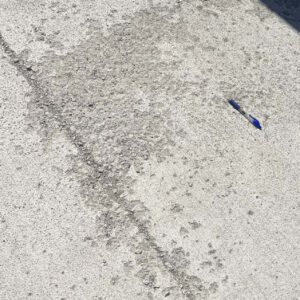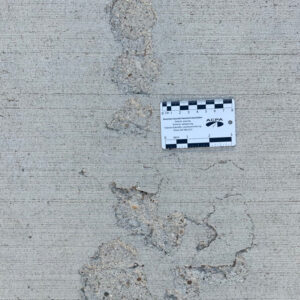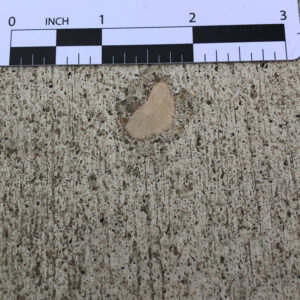SCALING CONCRETE SURFACES
What is scaling?
Scaling is a type of concrete surface deterioration that occurs when the surface of hardened concrete flakes or peels off due to the effects of freezing and thawing cycles, particularly when the concrete is saturated with water. This process can result in the removal of the top layer of the concrete, often to a depth of less than 1/8 inch, although it can be deeper, up to 3/8 inch. The scaling can manifest as patches of flaking or as mortar coming off individual coarse aggregate particles within the concrete. Although unsightly, scaling usually doesn’t impact the long-term performance of concrete.
Scaling can be avoided with proper planning, coordination, and execution by the Contractor. Contractor communication with the Client/Owner and Norwalk Ready Mix is crucial in this process.
Norwalk Ready Mix’s Responsibilities
We are responsible for providing a durable concrete mixture that is able to be placed and finished by the Contractor while meeting three general performance criteria.
- Water/cementitious (w/cm) ratio not to exceed 0.45
- Minimum compressive strength of 4,500 psi at 28-days
- Total air content of 5.5% to 8.5% by using an air entraining admixture for freeze-thaw protection
By adhering to these performance criteria, the ready-mix producer can provide a concrete mix that meets the desired standards for durability, strength, and resistance to environmental factors. This, in turn, sets a solid foundation for the contractor to successfully place, finish, and maintain the concrete, ultimately contributing to the longevity and quality of the finished construction project. Effective communication between the ready-mix producer and the contractor is essential to ensure that the concrete mix is tailored to the specific project requirements and conditions.
Contractor’s Responsibilities
The contractor plays the key role in avoiding scaling. They should:
- Slope the concrete at least 2% and divert water sources (downspouts, etc.) away from the concrete to prevent saturation. Saturated concrete (above 85%) is susceptible to freeze/thaw damage.
- Strike off the concrete without over manipulation. Vibrating screeds may be used to level concrete but shouldn’t be used to move it around. Screeds should be operated in the range of 3000 to 6000 vibrations per minute (50 to 100 Hz) and not left vibrating in one spot to avoid reducing air-entrainment and bringing excessive fines to the surface.
- After initial strikeoff and bullfloating, wait until the bleed water has dissipated and the concrete has begun to set before floating and texturing/brooming.
- Avoid using power finishing equipment or trowels (including Fresno trowels) which can reduce the near surface air-entrainment freeze thaw protection or create a weakened surface.
- Avoid adding water to the concrete that will cause a strength reduction. Examples of this are:
- Adding water on-site to the concrete mixture that results in the w/cm ratio exceeding 0.45.
- Finishing of concrete that works bleed water or precipitation back into the concrete surface.
- Sprinkling water onto the surface to aid in finishing or immediately beginning finishing after an evaporation retarder is applied.
- Be cautious when placing concrete during high evaporative conditions or when finishing delays occur and implement precautions to slow the evaporation rate such as using evaporation retarders, misting water above the slab, or erecting windbreaks. Evaporation rates near or exceeding 0.20 lbs./sq. ft./hr. for ordinary Portland cement mixtures or 0.15 lbs./sq. ft./hr. for mixtures containing fly ash or slag cement may result in early drying and weakening of the concrete surface.
- Cure the concrete. Implement effective curing methods to maintain moisture and temperature for proper concrete hydration for at least 7 days. This is one of the most important factors positively affecting concrete strength and durability. Not curing may result in up to a 30% reduction in surface strength and greatly increases the risk of surface scaling. Wet curing of concrete is best which may include ponding, sprinkling, or covering with wet materials, such as burlap, wet curing blankets, or plastic. Note that some coverings may cause discoloration of the concrete surface. Spray-applied curing compounds can also be used, but compatibility with sealers or coatings should be
considered. These compounds are wax, resin, or poly-alphamethylstyrene (PAMS) based (listed in order of increasing effectiveness) and must be applied uniformly according to manufacturer’s recommendations. - After the curing period, allow the concrete to air dry for at least a month prior to exposure to freezing conditions. Avoid late season placements when this is unlikely.
- Seal the concrete for added protection. Traditional concrete sealers are applied to the concrete surface to either form a film and/or penetrate the concrete usually after 2 to 4 weeks of drying. These sealers are siloxane, silane, and/or crystalline based and may need to be reapplied over time. Historically, penetrating breathable concrete sealers are used on non-decorative concrete. Some sealer admixtures that are mixed into the fresh concrete are also available. All sealer products should be thoroughly researched to determine the best product for the project and if compatible with the method of curing. Spray applied “Cure and Seal” products are considered moderately effective at both curing and sealing. To be most effective, curing and sealing are two separate distinct processes. The intent of curing is to retain moisture and sealing is to repel moisture.
- If the Contractor cannot or is not allowed to comply with the above 9 items, communicate and agree upon in writing that the Client/Owner accepts the increased risk of scaling.
Concrete Scaling Examples



Client/Owner Responsibilities
The Client/Owner also has a key role in helping prevent scaling. They should:
- Communicate project expectations with the Contractor prior to bidding.
- Insist on curing the concrete.
- Consider applying a concrete sealer if vehicles will routinely be parked on the concrete and/or the use of deicers is anticipated.
- Avoid the use of deicers in the first year. If traction is needed use plain sand.
- Remove excess sodium chloride (rock salt) used for deicing. Under usual conditions, sodium chloride may be used sparingly after the first year.
- Not use deicers containing magnesium chloride, calcium chloride, magnesium acetate, magnesium nitrate, ammonium sulphate, ammonium nitrate, or urea. These chemicals are often locally sold as deicers and will lead to premature deterioration of your concrete even though the label may say that it will not damage concrete.
- Keep fertilizers off concrete surfaces as they contain chemicals known to cause premature concrete deterioration.
- Remove snow and ice from concrete immediately. Snow and ice accumulation provides a constant source of water melt, increasing the odds of concrete saturation and freeze/thaw distress. Be aware that snow plowed onto your driveway from street snow removal efforts likely contains unwanted deicers.
Information sourced from concretestate.org
For additional information regarding concrete scaling, please view the brochure below:
Effects of Deicers on Concrete
